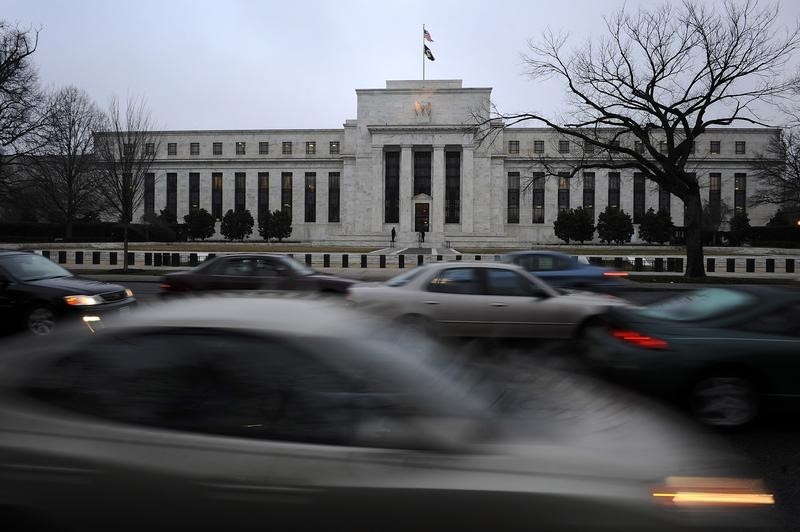(Adds details from Fed conference call and banks' own stress
tests)
By Lisa Lambert and David Henry
June 23 (Reuters) - Big U.S. banks are proving themselves to
be stronger and sounder in an annual regulatory stress test,
even as the Federal Reserve changes doomsday scenarios to keep
them on their toes.
On Thursday, the Fed said each of the 33 U.S. banks that
underwent its standardized stress test were able to stay above
minimum required capital levels in severe economic and market
conditions. Banks that participated last year also passed, but
their capital levels have largely improved since then.
Overall, the 33 banks would suffer $385 billion in loan
losses over nine quarters under the most severe scenario, the
Fed said. In aggregate, a key ratio measuring high-quality
capital against risk-weighted assets, known as the Tier 1 common
equity ratio, would drop to a low of 8.4 percent. That is well
above the 4.5 percent minimum set by regulators.
Since the Fed started stress testing banks in 2009, capital
levels have risen and credit quality has improved, with bad
loans rolling off the books. The Fed creates new inputs for
market and economic chaos each year, and shocked investors in
January when it included negative interest rates in the
worst-case scenario.
"Today's results are particularly notable given the more
stringent test assumptions above last year's test," said Richard
Foster, senior counsel for regulatory and legal affairs at the
industry trade group Financial Services Roundtable. "Banks now
hold extremely high levels of capital and liquid assets as
compared with historical averages."
However, Thursday's results are just one part of the Fed's
annual stress test process, and do not even offer a glimpse at
what many investors really want to know: Will banks be able to
use more capital for dividends and stock buybacks?
This first test - called the Dodd-Frank Act Stress Test, or
DFAST - is part of the sweeping financial reform law passed in
the wake of the 2007-2009 financial crisis. It relies on
standardized assumptions about capital levels and distributions
for the tested banks, allowing for a consistent view across the
industry.
Next week, the Fed will release results of a more nuanced
examination known as the Comprehensive Capital Analysis and
Review, or CCAR. That test evaluates banks' individually
tailored plans for surviving a crisis.
The Fed gives each bank a pass or fail grade for CCAR, based
not only on hard numbers, but also on qualitative measures. That
means the Fed can fail a bank because it did not approve of how
management went about the capital planning process.
"DFAST is sort of like a dress rehearsal for the CCAR," said
Ernie Patrikis, a partner at the White & Case law firm and a
former bank regulatory official at the Federal Reserve Bank of
New York.
Thirteen banks have failed CCAR since the Fed began
disclosing results, according to research firm Trepp.
In an analysis carried out before DFAST results were
released, Trepp analysts predicted two-thirds of the banks will
likely be allowed to increase their dividends. The percentage
approved for dividends has been ticking down from 72 percent in
2013 to 67 percent in 2014, and 61 percent in 2015.
"Banks generally are doing pretty well on earnings, so there
is capacity to increase their dividends," said Matt Anderson,
managing director at Trepp.
NEGATIVE RATE PAIN
The Fed will announce CCAR results on June 29. Failures are
embarrassing, and the Fed allows banks to resubmit capital plans
based on DFAST results to give them a second chance to pass.
They have until Saturday to do so.
Of the 33 banks that took part in DFAST, Huntington
Bancshares Inc HBAN.O produced the lowest minimum Tier 1
common equity ratio, of 5 percent, under a severely adverse
scenario. Morgan Stanley (NYSE:MS) MS.N and BMO Financial Corp produced
the weakest Tier 1 leverage ratio - another measure of capital
strength relative to assets - of 4.9 percent, under that
scenario.
Banks also released their own stress test results, based on
inputs set by the Fed. The figures did not necessarily match up.
For instance, Morgan Stanley's own capital ratios under severe
stress were higher than the U.S Federal Reserve test result, as
were Wells Fargo (NYSE:WFC) & Co's WFC.N and BMO's.
Banks that look marginal in DFAST may well have submitted
capital plans that include the issuance of securities that would
dramatically affect their capital scores. And, banks with strong
numbers can still fail CCAR because the Fed considered the
quality of their capital planning faulty.
Citigroup Inc (NYSE:C) C.N , for example, has had surprising results
for both reasons in the past. This year, Citi racked up big
gains, with its Tier 1 common equity ratio rising to 9.2 percent
from 6.8 percent and its Tier 1 leverage ratio improving to 6.9
percent from 4.6 percent.
Wells Fargo improved less, possibly because it relies more
on consumer deposits for funding and therefore could have been
hurt more by the negative interest rate scenario. The Fed
generally assumes that banks would not be able to pass along
negative rates to consumers by charging them for holding their
deposits.
Bank stocks rose on Thursday in anticipation of the stress
test results, as well as the Brexit vote. Citigroup was one of
the biggest beneficiaries, with its shares rising 4.2 percent to
close at $44.46, and gaining another 2.9 percent in after-hours
trading. <^^^^^^^^^^^^^^^^^^^^^^^^^^^^^^^^^^^^^^^^^^^^^^^^^^^^^^^^^^^
Graphic - Federal Reserve bank stress test http://tmsnrt.rs/28QAfLJ
^^^^^^^^^^^^^^^^^^^^^^^^^^^^^^^^^^^^^^^^^^^^^^^^^^^^^^^^^^^>
